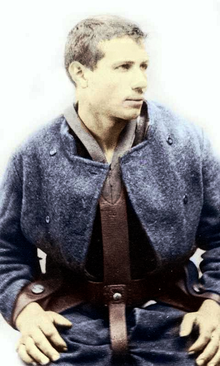Sante Geronimo Caserio
Sante Geronimo Caserio (the first name can be written both Santo and Sante , the middle name also Jeronimo , Ironimo or Heironymus ) (born September 8, 1873 in Motta Visconti in Lombardy ; † August 16, 1894 in Lyon ) was an Italian Baker and anarchist , best known for his assassination attempt on the President of the Third Republic, Marie François Sadi Carnot .
Life
Caserio was born into a farming family. He had many brothers and sisters, his father died in an asylum of pellagra , a malnutrition disease. He did not want to be dependent on his beloved mother and left home to go to Milan at the age of ten. There he found work as an apprentice baker. He came into contact with anarchist circles in the late nineteenth century and founded a small anarchist group himself called a pé ( On foot , transferred without money ). Pietro Gori remembered him as a very generous friend and of seeing him in front of the employment office, distributing bread to the unemployed and having anarchist leaflets printed on his meager salary. He was identified during a demonstration and sentenced to eight months in prison together with 200 other activists in a public hearing for distributing anarchist writings, which is why he first fled to Lugano and then moved to Vienna . In both places he worked as a baker. On July 21, 1893, he arrived in Lyon , where he worked briefly as a porter, and then moved to Sète , where he again worked as a baker and his idea of a "great deed" matured.
Assassination attempt and execution
Caserio was a propaganda representative and stabbed President Carnot on June 24, 1894 after a ceremony, also to avenge Auguste Vaillant and Émile Henry . In the process he described the process in detail with the words:
“I heard the Marseillaise and the shouts of 'Long live Carnot!' I saw the cavalry riding up. I understood the moment had come and I got ready. At the sight of the presidential car, I drew my dagger and threw away my coat. Then, when his carriage passed near me, I jumped on the step, pulled myself up by the car with my left hand and buried my dagger in the President's chest. "
Caserio did not try to flee, but ran after the fact jubilantly around the car of the dying and shouted "Vive l ' anarchy During the trial, he did not regret, asked for no leniency and turned down the offer to" mental illness to plead. Instead, he spoke out politically, saying:
“Well, if the governments are using the guns and the chains against us, and the prisons, do we anarchists have to defend our lives to stay locked up? No. Instead, we respond to governments with dynamite, with bombs, with pencils and with daggers. In short, we must do our best to destroy the bourgeoisie and the governments. You, who are the representatives of civil society - if you want my head, take it. "
The Gnadenrat decided against all appeals for clemency on 14 August to death by the guillotine and Caserio was on 16 August 1894 prison Saint-Paul of Louis Deibler executed. In the face of the guillotine, he shouted: “Coraggio cugini - evviva l 'anarchia!” (Courage, my cousins, long live anarchy!) As a result, the Lois scélérates enacted by the French Parliament were tightened.
literature
- Pietro Gori, In difesa di Sante Caserio , La Rivolta publishing house, Rome 1945. (Archived at the International Institute for Social History ; IISG Amsterdam. Under: Collectie IISG Plaatsnummer Bro An 270/416)
Web links
Individual evidence
- ↑ 1894: Sante Geronimo Caserio, anarchist assassin , accessed December 4, 2009.
- ↑ Original: I heard the "Marseillaise" and the cries of "Viva Carnot!" I saw the cavalry come up. I understood that the moment had come and I held myself ready. On seeing the President's carriage I drew my dagger and threw away the sheath. Then, when the carriage was passing close by me, I sprang forward to the step, supported myself by resting my left hand on the carriage, and with my right hand buried the dagger in the President's breast Caserio at the guillotine . In: The New York Times , August 16, 1894. Retrieved June 24, 2008.
- ↑ Original: Eh bien, si les gouvernements emploient contre nous les fusils, les chaînes, les prisons, est-ce que nous devons, nous les anarchistes, qui défendons notre vie, rester enfermés chez nous? Not… Vous qui êtes les représentants de la société bourgeoise, si vous voulez ma tête, prenez-la! . 24 juin 1894: Caserio poignarde Sadi Carnot, rue de la Ré à Lyon , accessed on December 4, 2009.
| personal data | |
|---|---|
| SURNAME | Caserio, Sante Geronimo |
| BRIEF DESCRIPTION | Italian anarchist |
| DATE OF BIRTH | September 8, 1873 |
| PLACE OF BIRTH | Motta Visconti in Lombardy |
| DATE OF DEATH | August 16, 1894 |
| Place of death | Lyon |


